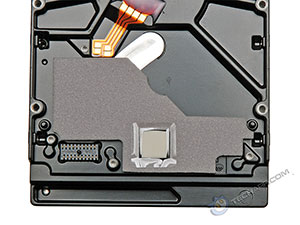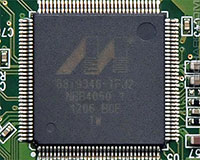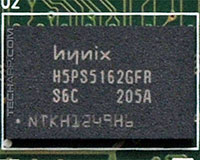Peeking Under The PCB
Western Digital has a penchant for keeping all surface-mounted components on the reverse side of the PCB, to prevent static damage and to allow for better cooling. With the PCB out of the way, you can see the gray thermal pad which helps to transfer heat from the controllers to the hard disk drive chassis.
 |
 |
The WD30EFRX drive uses the Marvell 88i9346-TFJ2 drive controller, which is incidentally the same controller used in the 1 TB Western Digital VelociRaptor (WD1000DHTZ) and the 4 TB Western Digital RE (WD4000FYYZ). This is a dual-core processor, which would boost its ability to handle multiple transactions simultaneously. It also uses an ST Microelectronics motor drive controller, which features the proprietary Smooth Drive pseudo-sinusoidal digital drive technology. Smooth Drive allows the hard disk drive to minimize torque ripple to reach a higher track density as well as reduce noise levels.
 |
 |
 |
It appears that Western Digital does not use a particular brand of SDRAM chip to provide the drive's 64 MB cache. In some cases, they used a Samsung DDR2 SDRAM chip. In our unit, Western Digital used the Hynix H5PS5162GFR-S6C which is a 64 MB DDR2 SDRAM chip, with 4 memory banks and an operating speed of 800 MHz DDR with 6-6-6 timings, slightly slower than the Winbond W9751G6JB-25 chip used in the 4 TB Western Digital RE (WD4000FYYZ). That said, its maximum transfer rate of 800 MB/s is fast enough to keep up with the SATA 6 Gb/s interface.
Connectors & Jumpers
 |
 |
This is a Serial ATA hard drive, with native support for SATA 6 Gb/s. However, it is backward-compatible so you will have no problem using it with older SATA 3 Gb/s controllers.
The SATA 6 Gb/s interface is necessary for optimal performance since this WD Red hard disk drive boasts a maximum sustained internal (platter-to-buffer) transfer rate of 145 MB/s and a large and fast cache.
Like all Serial ATA drives, it comes the standard SATA data (left) and power (right) connectors and is hot-pluggable. That means you can connect and disconnect this hard disk drive to your PC while it's still running. To the left of the SATA connectors is the jumper block.
From what we can tell, Western Digital ships some drives with a jumper and others without a jumper. Since our OEM unit did not come with one, it is likely that only retail drives come with the jumper.
According to Western Digital, jumpering pins 1 and 2 enables Spread Spectrum Clocking (SSC). Placing the jumper across pins 5 and 6 will force the drive to use the slower SATA 3Gbits/s transfer speed. This is only necessary for certain SATA controllers that do not properly implement the SATA 6 Gb/s speed negotiation.
Breather Holes
 |
The 3 TB Western Digital Red (WD30EFRX) hard disk drive does not have any clearly-marked breather holes on the top plate. The underside has two breather holes (see picture on the right) near the top of the drive. These holes must not be covered.
Breather holes allow condensation inside the hard drive to escape. They also equalize the hard drive's internal pressure with the ambient air pressure. The hard disk drive needs them to function properly, so please make sure you do not occlude the holes!
Support Tech ARP!
If you like our work, you can help support out work by visiting our sponsors, participate in the Tech ARP Forums, or even donate to our fund. Any help you can render is greatly appreciated!
Page |
Topic |
|
1 |
||
2 |
||
3 |
• The 3 TB Western Digital Red |
|
4 |
• Peeking Under The PCB |
|
5 |
||
6 |
• Testing The 3 TB Western Digital Red |
|
7 |
||
8 |
||
9 |
||
10 |
||
11 |
||
12 |
||
13 |
<<< The 3 TB Western Digital Red, Usable Capacity, Packaging : Previous Page | Next Page : WD Red Hardware Enhancements, Western Digital NASware >>>







 Add to Reddit
Add to Reddit
